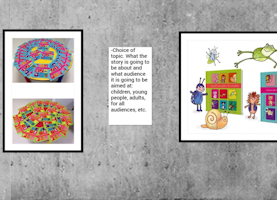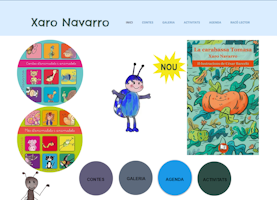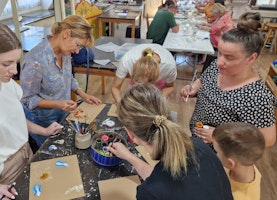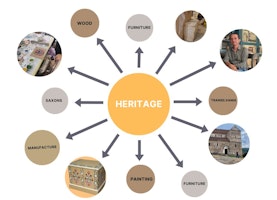Using external digital resources
A description of how external digital resources and repositories can be used in an art education project, with an example from the Irish pilot.

A description of how external digital resources and repositories can be used in an art education project, with an example from the Irish pilot.

Who are the people that have a key role in safeguarding heritage?

Tips for working with an expert in your chosen heritage field including: selecting a heritage topic, recruiting a heritage expert, working with a heritage expert, and examples of how these methods were used in the pilot studies.

Emaze is a useful digital tool for creating and sharing presentations, blogs and websites. It has been particularly useful for disseminating oral tradition in a visual and engaging way.

How many kinds of intangible cultural heritage influence people's everyday lives?

Find out something new about a tradition by changing the perspective. An object talks about human activity.

Helpful tips around organising a site visit, including understanding the purpose, choosing a location, planning and logistics and more.

Description of one sample exercise used in the Irish pilot, including step by step instructions provided by the art educator. Exercise: organising and carrying out a field trip to a local historical monument.

A sample exercise used in the Irish pilot study, including step-by-step instructions provided by the art educator. This exercise could be used in other minority language contexts, where there is a real or perceived language barrier to engaging with the intangible cultural heritage form.

A selection of exercises that can be applied to secondary school classes in history, geography, sociology, or other subjects.

Each heritage item preserves symbols which reflect feelings, thoughts and popular beliefs. Knowing these symbols and their meanings is part of the work of folk artists who succeed in passing them on to new generations. The methodology of this exercise can be adapted to any cultural context.

This working approach can be adapted to any context where the aim is to learn the craft techniques for making a heritage object based on art. In this case, painting is the field of artistic expression.

This exercise trains investigation skills and puts theoretical notions into practice by analysing and observing heritage objects in museum settings.

Study visits to heritage sites, museums and archaeological sites aim to develop specific skills, behaviours and attitudes to understand the importance of heritage education. See this example from Romania and adapt it to your heritage area.

Heritage is not an exclusively artistic field. This exercise is a case study where heritage is a field of economic activity. The exercise can be used in economics and career guidance classes.

One of the basic criteria that an artefact or a tradition must meet in order to qualify as heritage is age. This practical exercise helps students to understand this principle, to critically analyse a given item and to make value judgements. It can be adapted to any context that aims at heritage education.

This exercise is used to learn about ancestral symbols used in different cultures. This exercise can be used in English classes, intercultural education, or Art History.

This exercise helps recognize the oral traditions of a region through learning stories and words that older generations use.

A selection of useful tools from the LIVIND project, which focused on living heritage and sustainability

The exercise can be used in adult education as well as in schools. It fosters the ability to analyse heritage artefacts and identify cultural particularities.

Digital tools play an important role in safeguarding, promoting and preserving heritage. This exercise is aimed at both students and teachers of computer science in schools as well as university students of mathematics and informatics. Such an exercise can be accessed in any context and put to use according to one's creativity.

Digital tools play an important role in safeguarding, promoting and preserving heritage. Technology has given us what we now call the third category of heritage — digital heritage. Such digital heritage can be accessed in any context and put to use according to one's creativity.

Heritage education can also be included in mathematics lessons. Although it seems surprising, there is compatibility between the two areas. This exercise can be used in lessons of Fun Maths or Applied Maths.
